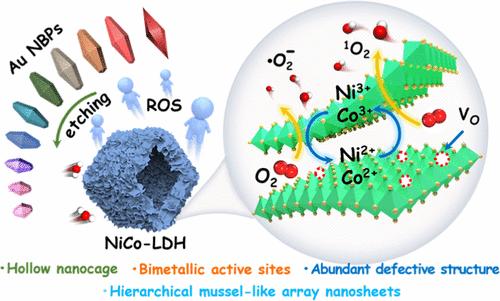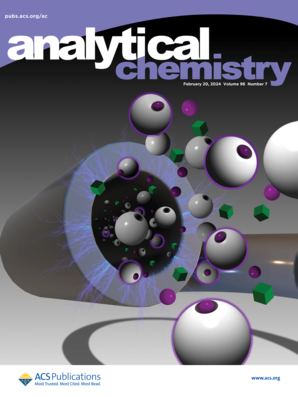Kirkendall Effect-Mediated Transformation of ZIF-67 to NiCo-LDH Nanocages as Oxidase Mimics for Multicolor Point-of-Care Testing of β-Galactosidase Activity and Escherichia coli
IF 6.7
1区 化学
Q1 CHEMISTRY, ANALYTICAL
引用次数: 0
Abstract
Early and portable detection of pathogenic bacteria is crucial for ensuring food safety, monitoring product quality, and tracing the sources of bacterial infections. Moving beyond traditional plate-culture counting methods, the analysis of active bacterial components offers a rapid means of quantifying bacteria. Here, metal–organic framework (MOF)-derived NiCo-layered double hydroxide nanosheets (LDHs), synthesized via the Kirkendall effect, were employed as highly effective oxidase mimics to generate reactive oxygen species (ROS). These ROS quickly etched gold nanobipyramids (Au NBPs), producing a vivid multicolormetric response. Experimental results and theoretical calculations indicated that the exceptional oxidase-like activity of NiCo-LDHs stemmed from the presence of bimetallic active sites and oxygen vacancies modulating the local electronic structure of LDHs. Additionally, β-galactosidase (β-Gal), a biomarker of Escherichia coli, reacted with p-aminophenyl-β-d-galactopyranoside (PAPG) to form p-aminophenol (PAP), a reducing agent which consumes ROS, thereby inhibiting the etching of Au NBPs. Furthermore, a three-dimensional (3D)-printed point-of-care testing (POCT) shell was designed as a portable device to visually detect β-Gal and E. coli in conjugation with smartphones. This study not only provides a novel approach to the rational design of nanozymes but also establishes a vivid and portably visual biosensing platform for detecting β-Gal activity and pathogenic bacteria.

求助全文
约1分钟内获得全文
求助全文
来源期刊

Analytical Chemistry
化学-分析化学
CiteScore
12.10
自引率
12.20%
发文量
1949
审稿时长
1.4 months
期刊介绍:
Analytical Chemistry, a peer-reviewed research journal, focuses on disseminating new and original knowledge across all branches of analytical chemistry. Fundamental articles may explore general principles of chemical measurement science and need not directly address existing or potential analytical methodology. They can be entirely theoretical or report experimental results. Contributions may cover various phases of analytical operations, including sampling, bioanalysis, electrochemistry, mass spectrometry, microscale and nanoscale systems, environmental analysis, separations, spectroscopy, chemical reactions and selectivity, instrumentation, imaging, surface analysis, and data processing. Papers discussing known analytical methods should present a significant, original application of the method, a notable improvement, or results on an important analyte.
 求助内容:
求助内容: 应助结果提醒方式:
应助结果提醒方式:


